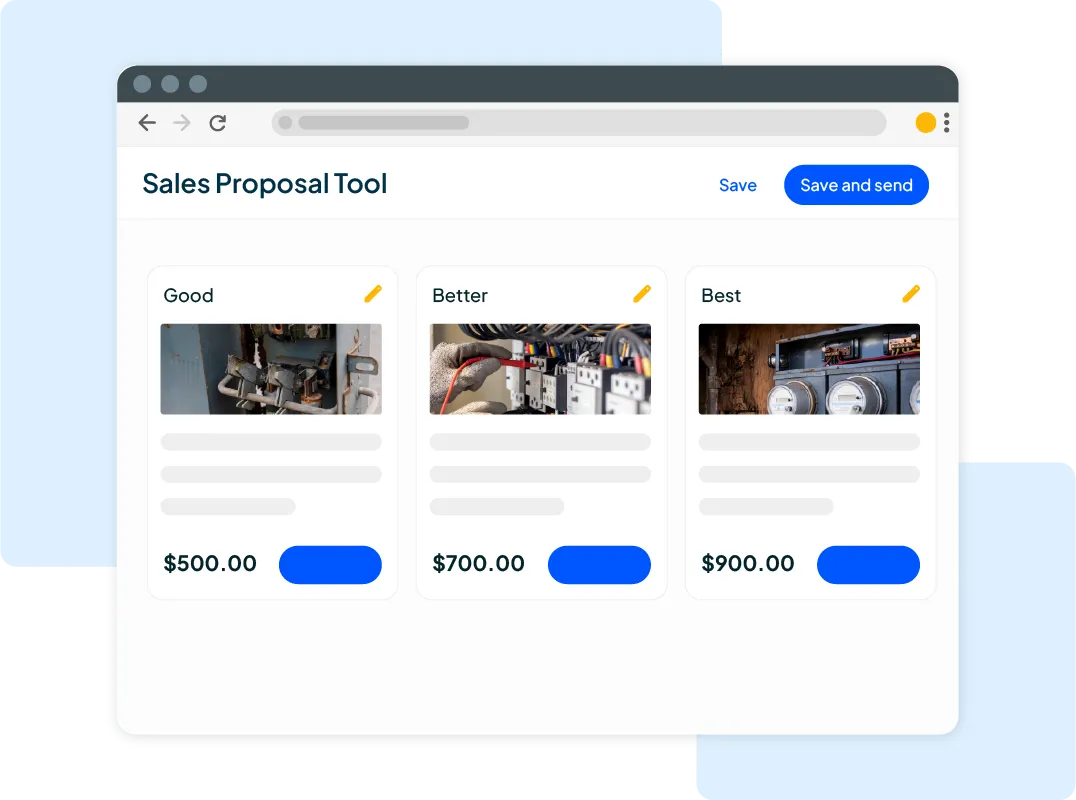Want to win more jobs with less effort?
Grow your business and send quick quotes with our home service software.

Want to see your potential revenue?
See what businesses like yours earn with Housecall Pro in 1 - 2 minutes.

From storm repairs to full home renovations, there’s no shortage of work for professional roofers. In fact, experts project the U.S. roofing industry to reach $58.1 billion in revenue in 2028. So if you have experience and drive, now’s a great time to launch your own business.
This guide walks you through every step of starting a roofing company, from licensing and business planning to marketing, pricing, and scaling up. You’ll also learn how Housecall Pro’s roofing contractor software can help you manage jobs, track clients, and keep your operations running smoothly.
Roofing business startup checklist
Keep these key steps in mind when starting your roofing business:
Get your roofing license: Meet your state’s licensing requirements, complete the necessary training, pass exams, and stay compliant with renewals and continuing education.
Write a business plan: Define your services, estimate your startup costs, and decide how you’ll fund your company.
Register and protect your roofing business: Choose a business structure, register your company, and secure insurance and bonding for safety, credibility, and client trust.
Invest in tools and price services wisely: Budget for essential equipment, choose a pricing model, and set rates that cover labor, materials, overhead, and profit.
Market and grow your roofing business: Build a brand, use online/offline marketing, collect reviews, hire strategically, and scale your services and service area over time.
Jump ahead
- Step 1: Get your roofing license
- Step 2: Create a roofing business plan
- Step 3: Secure business financing
- Step 4: Register and license your roofing business
- Step 5: Get roofing business insurance and bonding
- Step 6: Buy roofing tools and equipment
- Step 7: Price your roofing services
- Step 8: Market your roofing business
- Step 9: Grow your roofing business
- How much does it cost to start a roofing company?
- How Housecall Pro’s roofing software can help
Step 1: Get your roofing license
To start working as a roofing contractor, you’ll need to secure the right license for your state. While requirements vary, most states ask for both training and hands-on experience.
Here are the training paths to choose from:
- Trade school: Learn the fundamentals of roofing in a classroom setting. Most trade school programs in roofing take anywhere from six months to two years to complete.
- Apprenticeship: Train on the job and under the supervision of a licensed roofer. Apprenticeship programs usually last between two and four years. Though you’ll start at a minimal salary, you’ll also get paid while you learn.
- Both: Start with trade school for theory and then become an apprentice to master real-world skills.
While specifics differ by state, these are the general steps to get a roofing license:
- Meet the eligibility criteria of your state. Most states require you to be at least 18 and have between two and four years of roofing experience.
- Pass exams. Most states require a trade exam and often a business law exam (typically, a 70% score is needed).
- Submit your application form, exam results, and other requested documents to your state’s licensing board.
- Pay the application fee. Most boards accept credit cards, debit cards, or checks.
Once you have your roofing license, you’ll need to renew it every one to two years. Most states also require continuing education (CE) hours to keep your license active. For example, Florida requires 14 CE hours every two years; Oregon roofers need eight. Always check your state’s licensing board website for current requirements.
Step 2: Create a roofing business plan
A strong roofing business plan lays out your goals, how you’ll reach them, and the resources you’ll need to succeed. Here’s how to build a plan that sets your roofing company up for growth.
Research your market and competitors
Pinpoint your ideal customers. Are you targeting residential, commercial, or both? Whoever they are, learn what they value most—speed, quality, price—and what pain points you can solve.
Then, identify competitors in your service area using Google Maps, Yelp, and Angi. Look at their reviews, pricing, and services. Spot weaknesses in their approach, especially in negative customer reviews. For example, if people complain about slow response times, that’s your opportunity to commit to faster follow-ups.
Create a roofing services list
Your services list should balance what you do best with what your market needs. Start with your core services, then expand as your business grows. For example, you might begin with asphalt shingle replacements and minor leak repairs and add metal roofing or commercial contracts to boost profits once business is steady.
Here are some roofing services to consider:
- Roof installation (asphalt, metal, tile, flat, or solar)
- Roof inspections and repairs
- Gutter installation and cleaning
- Leak detection and emergency repairs
- Skylight or ventilation installation
- Insurance claims assistance
Set realistic goals
Setting goals helps you stay on track and gives you a means to measure your progress. Aim for growth, but keep your goals in line with your resources and market size. Here are examples of goals you could set for your roofing business:
- Short-term (first 6–12 months): Boost engagement by 15%, add 20 new clients, and keep your Google rating at 4.5 stars or above.
- Long-term (1–5 years): Expand into three new cities, hire at least 10 employees, and reach $500,000 in annual revenue.
Include other business plan elements
Besides market research data, services list, and your goals, here are other elements you should include in your business plan:
- Pricing strategy: Detail your process of setting rates that will cover labor, materials, overhead, and profit. This ensures your business stays profitable and customers can afford your services.
- Marketing plan: Highlight how you’ll win and keep customers. Cover digital tactics (SEO, social, Google Business Profile) and local efforts (flyers, yard signs, referrals).
- Operations plan: Itemize your day-to-day operations. This includes how you’ll schedule work, obtain supplies, and manage employees. Then, describe each player’s roles and explain how their skills will contribute to the overall success of the business.
- Financial projections: Show you’ve thought through your costs, revenue targets, and growth path for the next few years.
Pro tip: Track your costs, contracts, and profits using a field service tool like Housecall Pro. This makes financial projections easier—and more accurate.
Step 3: Secure business financing
Every roofing business needs upfront investment in tools, vehicles, insurance, and marketing. Even if you plan to start small, you’ll need enough funding to cover startup costs and keep your cash flow stable as you build your client base. Solid financing helps you weather slow seasons and gives you room to grow.
Here are some of the most common ways to fund your roofing business:
- Government funding: Some state or local programs offer low-interest loans or small grants for trade businesses. Check with your state’s Small Business Development Center (SBDC) or Department of Labor to see what support is available.
- Small Business Administration (SBA) loans: SBA-approved lenders provide loans specifically for small businesses that may not qualify for traditional bank loans. SBA loans often offer lower interest rates and longer repayment terms, making them a good choice for major expenses like vehicles or equipment.
- Business line of credit: This flexible option gives you access to a set amount of funds you can draw on as needed. You only pay interest on what you use, which is handy for covering slow periods or unexpected costs. Business lines of credit are available through banks, credit unions, and online lenders.
- Business grants: Grants are funds you don’t need to repay, offered by government agencies or private organizations. Check portals like Grants.gov or the Community Development Financial Institutions (CDFI) Fund. Competition is stiff, so apply early and keep backup options ready.
Step 4: Register and license your roofing business
To operate legally in your service area, you need to register your business with the right authorities. The process involves choosing a legal structure, applying for licenses, and keeping important documents organized.
Choose a business structure
How you set up your business will affect your taxes, liability, and growth potential. Here are the main options:
- Sole proprietorship: A business owned and operated by one person. You report all income and expenses on your personal tax return. The downside is that there’s no legal separation between you and the business.
- Limited liability company (LLC): An LLC protects your personal assets if your company faces a lawsuit or debt. This structure also offers tax flexibility and is easier to maintain than a corporation.
- Partnership: Two or more people share ownership, profits, and responsibilities according to a partnership agreement. It’s simple to start, but clear agreements are important to avoid disputes.
- Corporation: This structure makes your business an entirely separate legal entity, offering strong liability protection and easier access to investors. It requires more paperwork and comes with additional regulations.
Most roofing businesses choose an LLC or a sole proprietorship. While an LLC is great for the added protection and credibility, a sole proprietorship is a good choice if you want to keep things simple and skip the paperwork.
Apply for a business license
Once you choose your structure, you need a business license to operate legally. Here’s how to get started:
- Visit your city or county clerk’s website. Google “business license in [your city].”
- Check whether your state requires registration with the Secretary of State or a state contractor board.
- Submit your business details as requested.
- Pay the registration fee, which usually ranges from $50–$150.
Pro tip: Store digital copies of your licenses, permits, and proof of insurance in Housecall Pro for easy access.
Get In Touch: 858-842-5746
Let us earn your trust
On average, Pros increase monthly revenue generated through Housecall Pro by more than 35% after their first year.
See plan options and feature breakdown on our pricing page.
Step 5: Get roofing business insurance and bonding
The right insurance coverage protects your business against accidents, property damage, or legal disputes. Most clients and commercial projects require proof of insurance before they’ll work with you, so having the right coverage builds credibility and helps you land more jobs.
Here are the core insurance types every roofing business should have:
- General liability insurance: Covers accidents that happen on the job and property damage. For example, if falling debris damages a client’s car or a leak appears on the roof after a repair, liability insurance covers those costs. Experts recommend at least $1 million in coverage per occurrence.
- Workers’ compensation insurance: Required in most states if you have employees. This pays for medical bills and lost wages if someone is injured on the job.
- Commercial auto insurance: Protects your work vehicles against accidents, theft, or damage during business use. Personal auto policies usually exclude business driving. Aim for $1 million in coverage here as well.
- Bonding (surety bond): Guarantees clients that you’ll finish the job as promised, or provide a refund if things go wrong. Bonds are a must when bidding on commercial or government projects, and they signal reliability to customers.
It’s smart to get quotes from three or more insurance providers and compare them. This way, you get the best rate and avoid paying for unnecessary extras.
Step 6: Buy roofing tools and equipment
Investing in the right tools and equipment sets you up for safe, efficient, and professional work from the start. Clients notice when your team shows up prepared and well-equipped, and it helps you finish projects on time.
When planning your startup costs, factor in the following:
- Hand tools: Your day-to-day essentials for installation and repair work. Examples include hammers, knives, chalk lines, and roofing shears.
- Power tools: Speed up jobs and reduce fatigue with nail guns, cordless drills, impact drivers, angle grinders, and extension cords.
- Safety equipment: Roofing comes with real risks. Keep your crew safe with roof harnesses, hard hats, non-slip boots, gloves, and safety glasses.
- Vehicles: You need a reliable pickup truck, van with ladder racks, or utility trailer to haul tools, supplies, and crew members to each site.
As a new business owner, expect to spend between $10,000 and $25,000 on these tools. Budget more if you plan to hire a full crew or take on large commercial projects.
You can save money by following these tips when buying tools:
- Find trusted suppliers: Use local business directories or industry networks to get recommendations for reliable vendors.
- Buy used or refurbished: Check Home Depot, auction sites, and equipment resellers for deals—but always inspect tools for quality before you buy.
- Plan for maintenance: Set aside 5%–10% of your monthly revenue for repairs and eventual replacement, so you’re never caught short-handed on a big job.
Housecall Pro lets you manage tool inventory, schedule maintenance, and assign equipment to technicians. That way, you always know where everything is and which tools are due for maintenance.
Step 7: Price your roofing services
Pricing your services right keeps your business profitable and competitive. Price too low, and you risk losing money. Price too high, and you might turn customers away. Aim for rates that reflect your value and keep your business running strong.
Learn more: Proven Pricing Strategies to Maximize Profit and Win More Customers
Choose a pricing model
Roofing contractors typically use one of three pricing models, depending on project complexity and predictability of costs and work hours:
- Hourly pricing: Bill for labor by the hour. Use hourly pricing for small, unpredictable jobs (like an emergency leak repair) where material costs and time can vary.
- Flat-rate pricing: Charge a set price for a specific service, like a full roof replacement or gutter installation. Flat rates work best for standard jobs where costs are predictable.
- Hybrid pricing: Combine flat fees for standard services (like annual maintenance) with hourly rates for complex or custom work.
Once you decide on your pricing model, stick with it. Consistency shows clients what to expect and makes it easier for you to forecast profits.
Set your rates
Your rates should cover labor, materials, overhead, and your desired profit margin. Here’s how to price your roofing jobs:
- Calculate your base costs: Add up all direct expenses. These include employee wages, roofing materials, transportation, permits, and disposal fees.
- Add your profit margin: Target a healthy profit margin (typically 20%–40%), depending on the service and competition in the area.
- Research competitor pricing: Find out how much your competitors charge, and use your findings to position your pricing. You can match the market average, charge higher for premium service, or go lower to increase market penetration.
- Adjust for specialty jobs: Some complex jobs (like flat roofs or steep-slope repairs) require more time, skill, and risk. Adjust your rates to reflect these variables.
Getting your pricing right takes some testing. Start with solid estimates, track your profits per job, and adjust as you gain experience.
Step 8: Market your roofing business
Marketing helps keep your calendar full and sets you apart from competitors. The best approach combines both online and offline efforts.
Design your brand
People should remember your brand after visiting your website or seeing your truck in their neighborhood. It should feel professional, consistent, and true to what you offer.
You can follow these marketing tips for inspiration:
- Pick a clear, memorable brand name that tells people what you do. For example, “Skyline Roofing & Repair” is more straightforward than something like “Justin & Parker’s.”
- Design a professional logo that aligns with your goals and looks good on vehicles, uniforms, and business cards.
- Check that your domain and social handles are available across platforms.
- Use the same color palette and tone across all marketing materials to build trust and recognition.
Learn more: 20+ Roofing Company Name Ideas (and How to Pick One)
Build an online presence
Building your online presence grows brand awareness and helps customers find you when they need services. Follow these tips:
- Create a simple website with clear service descriptions, pricing, and contact information. Add a search bar and a menu for easy navigation.
- Claim your Google Business Profile and add your address, phone number, service area, and photos of recent work. This helps you appear in local “roofers near me” searches.
- Post on social media. Upload before-and-after project photos, short videos of your crew in action, and seasonal maintenance tips. Be active on the social media platforms your audience uses. Facebook, Instagram, and LinkedIn are great for reaching local homeowners.
- Ask for customer reviews after each job, then add them to your website and social media pages. People trust recommendations from real people.
Housecall Pro makes it easy to manage your website, send follow-ups, and track referrals all in one place. Try our website builder to create a professional, SEO-friendly site fast.
Use offline marketing strategies
Even in the digital age, traditional marketing is valuable for local service businesses like roofing. Follow these offline marketing tactics to reach local audiences:
- Distribute postcards, flyers, or door hangers in local neighborhoods.
- Go door-to-door after storms and introduce yourself.
- Network with business associations, real estate agents, and property managers for referrals.
- Set up a referral program to reward clients who send new business your way.
Learn more: See real examples of postcard marketing campaigns to get ideas for your company.
Step 9: Grow your roofing business
Once you have a steady stream of clients and consistent revenue, it’s time to focus on growing your business—but do it carefully. Scaling too quickly can overextend your team and cut into profits. The key is to grow sustainably.
Start by tracking your finances closely. If your profit margins look healthy and your job pipeline is full, you may be ready to grow. At this point, consider offering new services or moving into additional neighborhoods.
Hire roofing employees
You’ll eventually reach a point where you can’t manage every project yourself. Hiring employees is a big step toward building your company. You know it’s time to hire roofing employees when:
- You’re turning down jobs because your schedule is maxed out.
- You’re spending more time on admin work than on roofing.
- You have steady revenue and a backlog of booked projects.
According to the Society for Human Resource Management, the average cost to hire a new employee is around $4,700. Taking time to hire the right people helps you avoid expensive turnover.
Here’s how to hire effectively:
- Post job openings on trade boards, union sites, and social media community groups.
- Verify licenses, certifications, and past roofing experience before the interview.
- Ask situational questions to assess reliability, teamwork, and safety awareness.
- Be upfront about job conditions, hours, and pay rates to avoid mismatches.
- Onboard new hires with thorough safety training and clear site procedures.
- Pair new employees with experienced roofers for their first few weeks.
Document your installation processes and customer service expectations so everyone delivers the same standard of quality.
How much does it cost to start a roofing company?
Startup costs depend on your location, the services you offer, and whether you work solo or run a team. Most roofing businesses spend between $20,000 and $50,000 to get started.
Your most significant expenses will be equipment, insurance, and marketing. Still, you can lower initial costs by starting small, buying used tools, and renting more costly equipment until your business grows.
Here’s a general breakdown of typical startup costs:
- Equipment and supplies: $10,000–$25,000
- Licensing and permits: $500–$5,000
- Insurance: $2,000–$4,000 annually
- Marketing and branding: $5,000–$15,000
- Initial operational expenses (vehicle, uniforms, and small tools): $3,000–$6,000
How Housecall Pro’s roofing software can help
Managing a roofing business means juggling job schedules, estimates, payments, and client communication. Housecall Pro brings everything together in one easy-to-use platform so you can stay organized and focus on growing your business.
Here’s what you can do with our roofing software:
- Scheduling and client management: Schedule appointments, send automated reminders, and manage recurring jobs.
- Pricing and invoicing: Generate accurate quotes and estimates with integrated pricing calculators, and send professional invoices to clients.
- Marketing and client acquisition: Monitor your online reviews, automate follow-up messages after project delivery, and manage your referral program.
- Operational efficiency: Accept payments and fill out digital forms from your mobile phone.
- Growth support: Manage employees, subcontractors, and multiple locations as you scale.
Housecall Pro reduces admin time, boosts efficiency, and helps you deliver the kind of service that brings customers back. Sign up for a 14-day free trial to start your roofing business on the right foot.
FAQ
-
How can I find customers for my new roofing business?
-
To find customers for your roofing business, claim your Google Business Profile and ask happy clients for reviews. Share before-and-after photos and helpful tips on social media. Network with real estate agents and property managers, since they often need reliable roofers for their own clients.
-
Do I have to register my roofing business?
-
Yes, you must register your roofing business if you want to operate as an LLC, corporation, or partnership. Registering your business allows you to open a business bank account, qualify for business loans, and present a more credible image to customers and partners.
-
How long does it take to become a licensed roofer?
-
It can take anywhere from 2–4 years to become a license roofer, depending on your state’s requirements. Most states require hands-on experience or an apprenticeship, followed by passing a trade and/or business exam.
-
Can I start a roofing business with no money?
-
Yes, you can start a roofing business with no money. Look into small business loans or grants for new contractors. You could also partner with someone who already has equipment or capital, and split profits as you build your business. Starting small and reinvesting profits can help you grow without a significant upfront investment.







